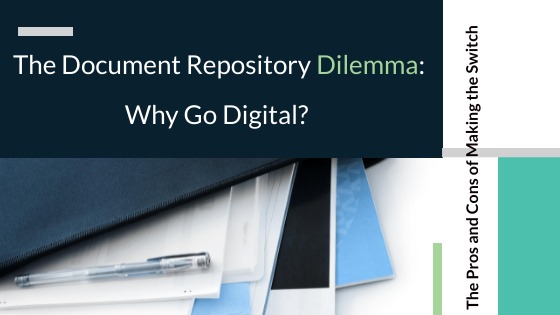The Pros and Cons of Making the Switch to Digital Documentation.
As a business leader, you’re likely to encounter a pivotal question at some point: should our company digitize its document repository? This question is far from straightforward and demands careful consideration, as the answer isn’t a simple yes or no. The choice between maintaining a traditional paper-based system or transitioning to a digital repository entails weighing a multitude of pros and cons. Moreover, the optimal solution for your organization hinges on various factors, including the nature of your business, your workflow processes, and your long-term strategic goals. In this comprehensive blog post, we aim to shed light on some of the critical aspects you should contemplate as you ponder this significant decision.
Embarking on the journey to digitize your documents can seem daunting, but understanding the benefits and drawbacks can significantly aid in making an informed choice. Here’s a deeper dive into the pros and cons of digital document management, tailored to guide you through this decision-making process.
The Pros of Going Digital
There are many benefits to digitizing your document repository. Perhaps the most obvious is that it can save your business money. Printing and storing paper documents is expensive, and it’s only going to get more expensive as time goes on.
As real estate prices continue to soar, space of any kind only becomes that much more valuable. We know paper documents take up physical space, which means you’ll need to lease or purchase more office space as your business grows. By digitizing your documents, you can free up valuable office space for other purposes.
Another advantage of digitizing is that it can help your team be more organized and efficient. With paper documents, it’s easy for things to get lost or misplaced. It can also be difficult to track who has access to which documents. With a digital repository, all your documents are stored in one central location where they can be easily accessed by authorized users. This makes it easier to keep track of changes and ensures that everyone is always working with the most up-to-date version of each document.
Finally, digitizing can help protect your documents from fire or flood damage. Paper documents are vulnerable to both hazards, but digital files can be backed up and stored in a secure location off-site or on the cloud. This means that even if disaster strikes, your critical business documents will be safe and sound.
Digitizing your business documents can bring about a plethora of benefits, some of which are listed below:
- Improved Accessibility and Sharing: With digital documentation, all your files and records are available at the click of a button. This not only makes it easier for you to retrieve critical information but also enables seamless collaboration among team members, even if they are working remotely. Furthermore, digital documents can be quickly shared with clients and partners, reducing the need for physical copies and postal services.
- Efficiency and Time-Saving: Digital documentation eliminates many of the manual tasks associated with traditional paper-based systems. This results in increased efficiency as employees spend less time organizing, searching for, and filing documents. Additionally, digitized processes like e-signatures and automated workflows can significantly reduce the time it takes to complete tasks and approvals.
- Cost Savings: Transitioning to digital documentation can help businesses save money in various ways. For one, it reduces costs associated with paper, printing, storage, and transportation of physical documents. It also eliminates the need for additional office space dedicated to storing boxes of paper files, freeing up valuable real estate. Additionally, digital documents reduce the risk of human error and lost or damaged physical copies, saving businesses from potential financial losses.
- Eco-Friendly: Digitizing your documents can have a positive impact on the environment by reducing paper waste. According to estimates, an office worker uses around 10,000 sheets of paper per year, and a significant portion of that ends up in the trash. By making the switch to digital documentation, businesses can significantly reduce their carbon footprint and contribute to a greener future.
The Cons of Going Digital
While there are numerous benefits to digitizing your documents, there are also some potential downsides that should be considered before making the switch:
- Upfront Costs: The process of digitizing your documents can be a significant investment, especially for large organizations with vast quantities of physical files. Depending on the size and complexity of the project, businesses may need to invest in document scanning equipment, software, and training.
- Security Concerns: With digital documentation comes the risk of cyber threats such as hacking and data breaches. Businesses must implement robust security measures and protocols to protect sensitive information, which can be costly and time-consuming.
- Employee Training: Adopting a digital document management system requires employees to adapt to new processes and technology. Depending on the complexity of the system, this may involve significant training for all personnel, which can initially impact productivity.
- Dependency on Technology: With all your critical documents stored digitally, businesses may face significant consequences if there are any technological failures or power outages. This can result in a temporary loss of access to vital information and disrupt business operations.
Of course, there are also some potential drawbacks to digitizing your document repository. You’ll need to first do the work and figure out which system is right for your business needs. The second is that it requires a significant upfront investment. You’ll need to purchase software and cloud storage for storing and accessing your digital files; you may need to hire staff to manage the system. In addition, migrating all your existing paper documents into the digital world can be time-consuming if you are doing it in-house and a costly process if you choose the wrong system. However, keep in mind that these upfront costs are often offset by long-term savings on things like paper, storage space, printing costs, and time.
Another potential downside of digitizing your document repository is that it requires reliable internet access. If your internet connection goes down, you won’t be able to access your digital files, unless you have the document already opened you will need to wait for your internet access to come back on. This could cause significant disruptions for businesses that rely heavily on their document repositories. However, there are ways to mitigate this risk by storing critical files locally on computers, although I warn against this in most cases or servers as well as in the cloud. Most businesses today store files on the cloud as it is the most cost-effective and easily accessible.
As you can see, there are both pros and cons to digitizing your document repository. The best solution for your business will depend on a variety of factors including the budget, needs, risks, and preferences. Weigh all of these considerations carefully before making a decision about whether or not to go digital with your document repository.
Conclusion
The decision to transition to digital documentation should not be taken lightly. As with any major organizational change, it requires thorough consideration of the pros and cons, as well as careful planning and implementation. However, for many businesses, the benefits of going digital far outweigh the potential downsides. Improved accessibility and collaboration, increased efficiency and cost savings, as well as a reduced environmental impact, are just some of the significant advantages that come with making the switch to digital documentation. By carefully analyzing your organization’s specific needs and goals, you can make an informed decision about whether or not digitizing your documents is the right choice for your business.
So, it’s crucial to weigh all the factors and carefully consider the pros and cons before making this significant change. Regardless of the decision you make, remember that technology is constantly evolving, and it’s always possible to adapt and make adjustments in the future if necessary. Embrace change and embrace the digital era – it may just be the key to unlocking new levels of productivity and success for your business. As you continue to evaluate your options, keep in mind that document digitization is not an all-or-nothing proposition.
Many businesses choose to implement a hybrid system, where some documents are retained in physical form while others are stored digitally. Ultimately, the best solution will depend on your unique business needs and goals. So, whether you decide to fully embrace digital documentation or take a more gradual approach, the important thing is to make a well-informed decision that will benefit your organization in the long run. With careful planning and implementation, digitizing your documents can bring about numerous benefits for your business – and with technology advancing at a rapid pace, the possibilities for even greater efficiency and innovation are endless. It’s time to embrace the digital revolution and take your business to the next level! So, don’t let the fear of change hold you back – start exploring your options for digitizing your documents today and see how it can transform your organization for the better.
There’s no easy answer when it comes to deciding whether or not to digitize your documents — it depends on a variety of factors specific to your business needs and preferences. If saving money is important to you, and you want greater efficiency and organization, or if you’re concerned about protecting your documents from fire or flood damage. Then digitizing your document repository might be the right choice for you!
We take a thorough and flexible approach to streamlining your operations and choosing the right technology for your business. If you’d like to find out more, contact us to schedule a consultation.







